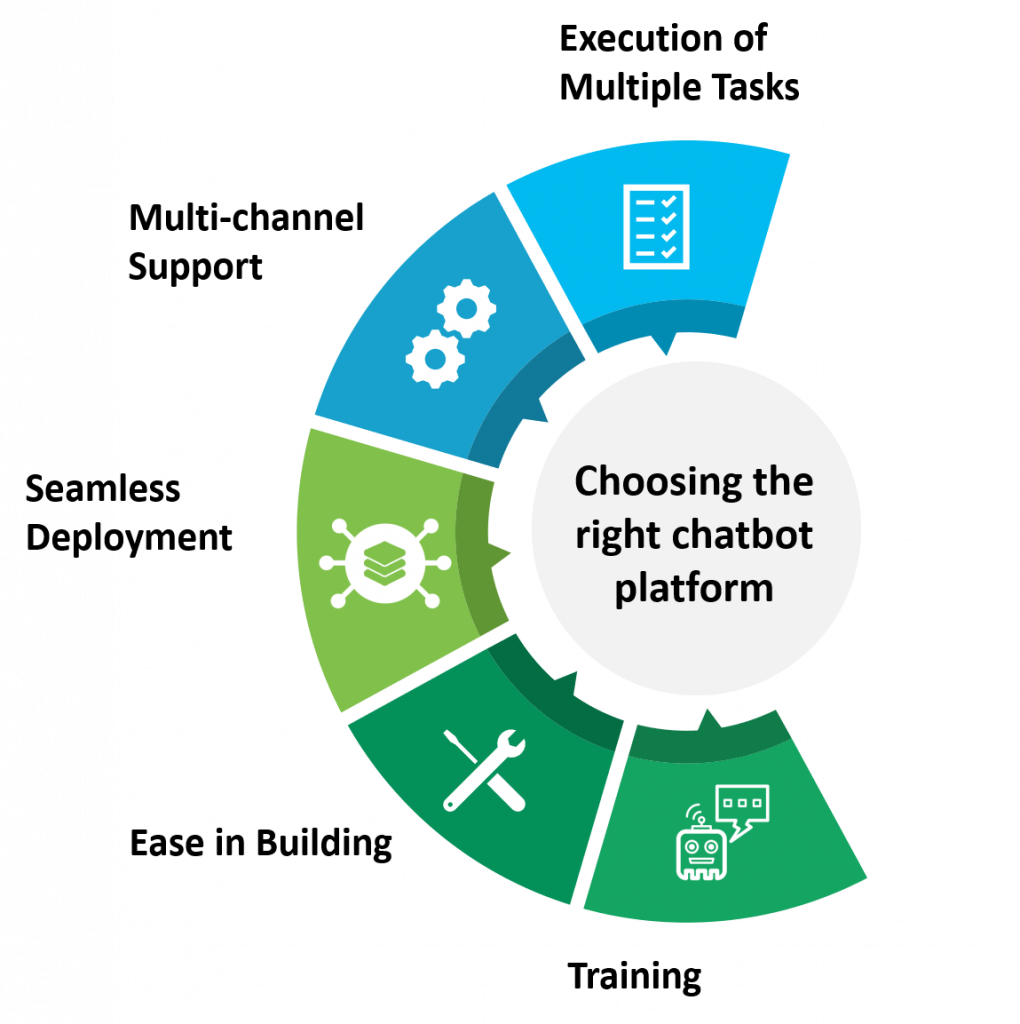



Customer Experience & Chatbots
Customer experience has emerged as the key differentiator for every business. In today’s customer empowered marketplace, maximizing 360-degree customer experience has taken precedence over any business profits. In this era of intelligent automation, customers need information at the mouse click and the blink of an eye. If your customers are a part of online customer experience, speed and accessibility of information are paramount. Else it can lead to a potential loss of customers or weaken the brand value.
Chatbots are one of the most well-known examples of artificial intelligence. Industry titans such as Apple, Amazon, Google, Microsoft have built their conversational agents such as Siri, Amazon Alexa, Google Assistant, and Cortana, respectively. Enterprises today are leveraging chatbots to automate their processes, help better serve their customers, market their brand and sell their products.
According to a Gartner study, 85% of our interactions will be handled by chatbots instead of humans. As artificial intelligence and machine learning technology trends advance faster, it has become a necessary strategy for businesses to integrate chatbot technology into enterprise operations. To build a successful chatbot, here are some key elements you should keep in mind.

Things Businesses Should Consider While Building Chatbots
The Type of Chatbot: Enterprises will have to choose the right type of chatbot for their business.
- Rule-based Chatbots
- Artificial Intelligence-based Chatbots
Rule-based chatbots are bots programmed to answer questions based on specific queries and scripts. Depending on the enormity of the business process, these scripts can be simple or complex. On the contrary, AI-based bots are fuelled by artificial intelligence, including natural language processing (NLP) and machine learning. These bots progressively grow with every human interaction. A single task bot is not a practical alternative for enterprises that need an automated workflow. This is coupled with the integration of internal and external ecosystems in addition to the application of natural language processing.
Define the Purpose: It is essential for businesses to identify the key areas where chatbots can be the right fit. Start slow, define the business challenges and in what part of the customer journey will chatbots be most appropriate. These can be in your marketing communication, sales pipeline and customer service.
Your Customers & Their Intent: Post defining the purpose, it is vital to understand your targeted audience – customers. Their expectations from a chatbot, the pain points chatbots might resolve, the messaging platform and the tonality of the conversation. Employment of a chatbot and achieving the customer’s goal will enhance the value for customers and the brand.
Accessibility across Multiple Channels: Chatbots should be readily available and accessible across multiple channels. This includes integration across numerous internal business systems, including customer relationship management systems, supply chain, etc.
Seamless User Experience: The customer experience should be superior in the human-machine interaction. Users need to know whether the virtual assistant is a chatbot or a human. It is effective when you demonstrate the capability of a chatbot and how they can assist users in the customers’ online experience.
The Importance of Chatbot Platforms & Choosing the Right One:
Now, you’ve decided on the purpose and area of employing a chatbot. The significant challenge is how to build a functioning chatbot to serve the purpose. And one of the easiest ways is to make use of a chatbot platform.
Chatbot platforms on an enterprise-level make it easier and effective to build a bot as the use case is interconnected and demanding. There is a gamut of chatbot platforms that help your business add more functionalities to your chatbot by creating a flow, providing machine learning capabilities and API integrations.
When it is considering a Chatbot architecture, one should consider using the right technology, assess business needs, technical capabilities, multiple channel support and other requirements necessary for building and deploying these intelligent chatbots.
Things to remember before choosing a chatbot platform for your business:

Kore.ai Chatbot Platform vs. Dialogflow Chatbot Platform
In this blog, we will consider two chatbot platforms – Kore.ai and Dialogflow with salient features, differentiators and benefits. This will simplify your search for choosing an effective platform for building your chatbot.

Kore.ai Chatbot Platform: The Kore.ai technology platform provides technical and business elements to develop intelligent bots and manage the chatbots throughout their lifecycle. At the core of the platform is the NLP engine, designed with award-winning technology that mixes multiple intelligence strategies to know human utterances and intents, together with sentiments and emotions.
The Kore.ai bot Builder offers developers flexibility in defining the categories of tasks their bot can perform - take action, deliver alerts, answer queries, manufacture on-demand or scheduled reports, or execute workflows.
You can customize responses to inject personality and use session context and variables to recollect relevant data concerning users. Responses may be custom and varied for a specific channel to produce a rich experience. In addition, you can even train the bot to interact with users in natural language.
Features like intent and field recognition, synonyms, and patterns create chatbots engineered with Kore.ai more successful at recognizing intent and providing satisfying user experience. Using bot Builder, you'll develop your own bot. The user query is mapped with intents outlined and as soon as the intent is matched, bot interacts to respond for given user question.
Kore.ai offers SDKs as a group of platform-specific client libraries that offer a fast and convenient way to get Kore.ai bots platform capability into custom applications and provide you with additional control for the chatbots.
There are different kinds of tasks you'll create. To name a few – action task, dialog task, information task etc. To begin with, produce action task – It queries a user on demand for input parameters, then executes an internet service call alongside a confirmation message, for instance, produce a new ticket, or Get Weather for this Location.
Chatbots built using the Kore.ai platform can be integrated with different platforms like Facebook, Telegram, Alexa, web application, Skype etc. This integration with your web application may be done in easy steps using Kore.ai web SDK.
User response can be custom based on IF-ELSE statements added directly into nodes with conditional connectors. Businesses can conditionally traverse through nodes; conjointly customize API responses simply without changing anything at the server’s end.
Google Cloud Dialogflow Chatbot Platform – Google Cloud Dialogflow is a chatbot development platform, especially for intent-based chatbots. Dialogflow uses knowledge like examples, contexts, annotations etc. to match the user queries to an acceptable intent. It then returns the output as a JSON response object that relies on the actionable information within the question text. The platform incorporates Google's machine learning expertise and products like Google Cloud Speech-to-Text.
It presently has SDKs for Android, iOS, Cordova, Unity, Xamarin, HTML, JavaScript, Node.js, Epson Moverio, Botkit, .NET, C++, Python, Ruby, PHP, and Java. The chatbot platform supports 14 languages in total.
Moreover, Dialogflow is equipped with a training module that tracks user’s requests and shows the administrator how it matched them to the intent. The admin can correct problems if any, and the machine re-trains itself accordingly.
If you are looking at a free license and enterprise edition chatbot platform, Dialogflow is the recommended platform. However, a drawback with Dialogflow is non-permittance to host your own instance of an agent. So, security is a concern if you use it for enterprise-level applications.
When you utilize Dialogflow, you produce agents that will perceive the huge and varied nuances of human language and translate that to plain and structured data that your apps and services can perceive.
Dialogflow allows easy integration of your chatbot with different platforms like Facebook, Telegram, Alexa, web application, Skype, IVR Voice Support, etc.
How can Xoriant help you with Chatbots?
Chatbot platforms are essential for building a chatbot. Xoriant has been at the forefront, working with a product engineering pedigree in partnership with leading technology companies and ISVs for three decades. We bring the expertise of working with new-age digital technologies in chatbot development. Our highly skilled in-house development team uses different chatbot platforms and proof of concept approach to building a chatbot for your specific business scenario.
Xoriant Chatbot Use Cases
Our chatbot use cases include creating a proof of concept to build a chatbot capable of connecting ten different organization level applications. This was created to avoid the users from being able to avoid multiple logins to different applications and perform respective actions. While building such a chatbot using Google Cloud’s Dialogflow, we explored its capabilities which is not limited to:
- Integration with different applications using fulfillment
- Display options as a card to the user
- Display images, tabular data, URLs, etc
- Ability to walk a user through the workflow guiding the next stages
- Ability to smartly identify the user’s intent
Similarly, Xoriant developed an interactive chatbot for a BFSI client to aid business executives with centralized access to financial data across different business lines. The interactive chatbot built using the Kore.ai platform saved crucial user time with quick query responses, improved user experience, reduced manual errors by providing accurate data. Some notable Kore.ai capabilities during the project include:
- Web SDK integration of Kore.ai bot to show the bot inside the web application
- Feature for SSO authentication to avoid hardcoding for user details
- Easy transferability of details from application to bot platform
- Smart identification of user utterance
- Displaying user response as a table, image, URL, chart, etc.
- Different types of entities for supporting all kinds of data like date, time, list, etc.
- User session management can be done for user’s utterances
- Bot analysis to discover frequent users, frequent queries etc.
Click here to know more about Xoriant Product Engineering services
References


 View Previous Blog
View Previous Blog




